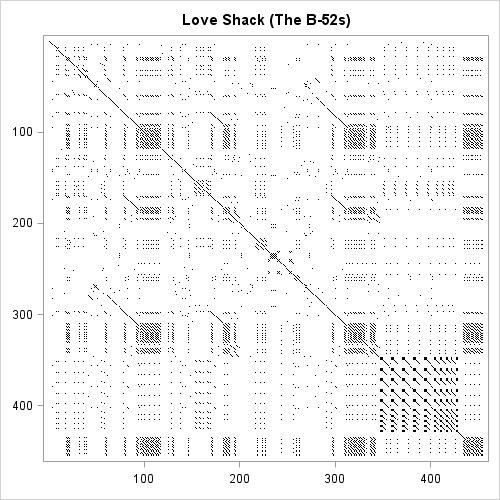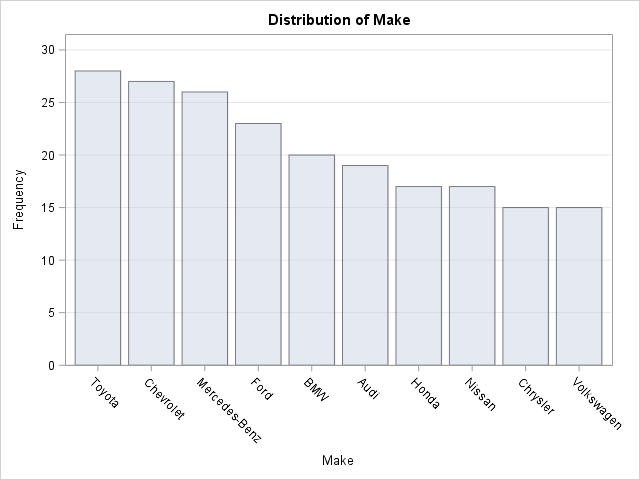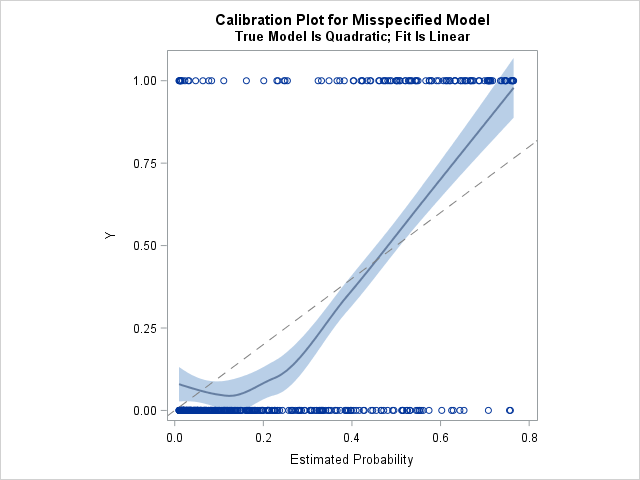Last year, I wrote more than 100 posts for The DO Loop blog. Of these, the most popular articles were about data visualization, SAS programming tips, and statistical data analysis. Here are the most popular articles from 2018 in each category.
Data Visualization

- Visualize repetition in song lyrics: In one of my favorite posts of the year, I use SAS to visualize the "repetition matrix" that shows how words and phrases are repeated in the lyrics of some popular songs. I had so much fun writing the post that I revisited it in December to visualize repetition in Christmas songs.
- Rating US Presidents: 166 experts in political science ranked the 44 US presidents on "greatness scale." You can use SAS to visualize the ranking of US presidents according to these experts.
- Customize legends in statistical graphs: In two articles, I showed ways to customize the legends in SAS statistical graphs. First, I showed how to combine symbols and line patterns in a legend by using the new LEGENDITEM statement. Later, I showed five ways to customize a legend in the SGPLOT procedure.
General SAS programming techniques
- CLASS versus BY variables: What is the difference between the CLASS statement and BY variables in SAS? When should you use one instead of the other in a SAS procedure?
- How to create a "Top 10" table and graph: Often it is useful to visualize the largest (most frequently occurring) categories of a categorical variable. This article shows how to use PROC FREQ to display only the top 10 levels (or five, or three,...) of a categorical variable.
- How to use DATA _NULL_ step: When you use the keyword '_NULL_' as the name of a data set, the output is not written. This article shows six reasons to use the _NULL_ data set in your SAS programs.
- FIRST.variable and LAST.variable in a BY-group: This article gives several examples of how to use the FIRST.variable and LAST.variable indicator variables for BY-group analysis in the SAS DATA step.
- Specify lists of variables in SAS: The SAS language provides syntax that enables you to specify lists of variables. This article describes six ways to specify a list of variables in SAS, including SAS keywords and syntax such as hyphens, colons, and double hyphens.

Statistics and Data Analysis
- New random number generators in SAS: Have you heard that SAS has a slew of new random number generators? Read about why you might want to use a new random number generator (RNG) instead of the default RNG. Or, you can watch a video about the new SAS random number generators.
- Calibration plots: A calibration plot for a binary response model can help you to rank subjects according to risk. It also is a way to diagnose lack of fit in a model. Learn about calibration curves and how to use a smooth curve to compare the predicted and empirical probabilities for the data. The SAS developer of PROC LOGISTIC liked this article a lot, so look for calibration plots in a future release of SAS/STAT software!
- Bootstrap methods in SAS: I published six bootstrap articles in 2018. The most popular demonstrate how to bootstrap the statistics in a two-sample t test. You can use the BOOTSTRAP statement in PROC TTEST or you can go "old school" and manually perform a bootstrap analysis for the t test.
- Chi-square tests in SAS: The chi-square test is a fundamental hypothesis test for testing the proportions of categorical variables. My first article shows how to compute a two-variable chi-square test for association in SAS. A second article shows how to specify the proportions for a one-way chi-square test of proportions.

I write this blog because I love to learn new things and share what I know with others. If you want to learn something new, read (or re-read!) these popular articles from 2018. Then share this page with one of your colleagues. Happy New Year! I hope we both have many opportunities to learn and share in 2019!

2 Comments
It's always a pleasure to read, learn and share your blog posts Rick. Over 100 blog posts in 2018 - WOW! You're such a DOer... ;-)
Pingback: 10 posts from 2018 that deserve a second look - The DO Loop